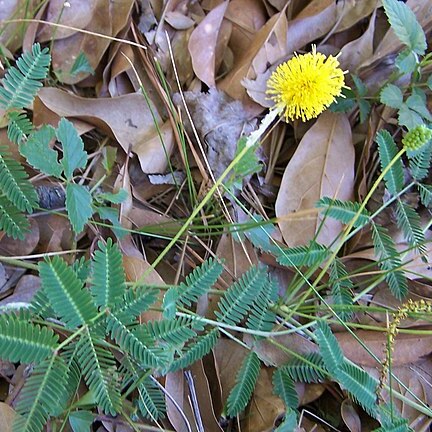Herbs, perennial, sometimes prostrate or floating, unarmed. Leaves bipinnate, sensitive to touch; stipules obliquely cordate, membranous; rachis with or without glands; pinnae not glandular; leaflets opposite, several to numerous pairs, small. Heads solitary, ovoid-globose, pedunculate, with bisexual flowers in distal part and sterile flowers with elongate staminodes at base. Calyx campanulate, shortly 5-dentate. Petals 5, free or fused at base. Stamens 10, rarely 5, free; anthers with or without a small gland at apex. Staminodes 10, petaloid and elongate in neuter flowers. Ovary stipitate; ovules numerous; style filiform; stigma concave. Legume deflexed from stipe, oblong, plano-compressed, subseptate between seeds or rarely 1-seeded. Seeds transverse, ovoid, compressed, funicle filiform.
Terrestrial or aquatic herbs, sometimes subwoody, with bipinnate leaves. Leaves stipulate; pinnae 1–5 (–6)-jugate, each with several to numerous pairs of opposite leaflets and with a pseudostipel sometimes subtending each pair of basal pinnae; petiole eglandular or with conspicuous flat gland. Inflorescence axillary; heads solitary or paired globular to ellipsoidal; peduncles bearing a pair of ±foliaceous bracts. Flowers 5-merous, dimorphic; upper perfect and lower only staminate; perianth green or yellow; sepals connate; petals free. Stamens 5 or 10, free, sterile or fertile; anthers commonly with apical gland. Pod flat, stipitate, oblong to ± circular, dehiscent on both sutures. Seeds transversely or rarely obliquely arranged in pod, compressed; pleurogram present.
Unarmed terrestrial or aquatic herbs. Stipules not spinescent. Leaves bipinnate, sensitive to the touch, rachis with or without extrafloral nectaries, pinnae eglandular; leaflets opposite. Inflorescences consisting of a pedunculate, solitary, axillary, elliptic glomerule, with bisexual flowers in the distal part, and sterile flower with ± elongated staminodes at the base. Calyx connate, with 5 valvate teeth. Petals 5, free or ± fused at the base. Stamens 10, free, all fertile in the bisexual flowers; anthers with or without a small caducous gland at the top. Pods fascicled, membranous to subcoriaceous, flattened, straight, dehiscent, endocarp not separating from the exocarp. Seeds ± flattened, brown, with a hard brown testa with pleurogram.
Herbs, aquatic or terrestrial, unarmed. Leaves bipinnate; pinnae each with several to numerous pairs of leaflets. Inflorescences of globose to ellipsoid heads which are solitary and axillary. Flowers in upper part of head hermaphrodite, in lower part of head ♂ or neuter with ± elongate staminodes. Calyx 5-toothed. Corolla-lobes 5, free or ± united. Stamens 5 or 10, free, all fertile in hermaphrodite flowers; anthers glandular or not at apex. Pods clustered, membranaceous to subcoriaceous, oblong to suborbicular, compressed, not contorted or spiral, dehiscent. Seeds ± compressed, oblong-ellipsoid to obovoid, smooth.
Pods clustered, membranous to subcoriaceous, oblong to subcircular, compressed, not contorted or spiral, dehiscent.
Flowers in upper part of head hermaphrodite, in lower part of head male or neuter with ± elongate staminodes.
Stamens 5 or 10, free, all fertile in hermaphrodite flowers; anthers glandular or not at the apex.
Leaves 2-pinnate, pinnae each with several to numerous pairs of leaflets.
Inflorescences solitary and axillary, of globose to ellipsoid heads.
Seeds ± compressed, oblong-ellipsoid to obovoid, smooth.
Herbs, aquatic or terrestrial, unarmed.
Petals 5, free or ± united.
Calyx 5-toothed.

